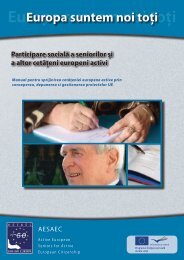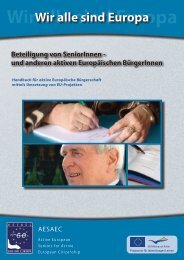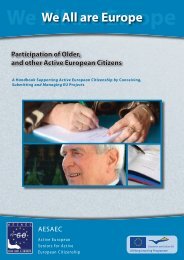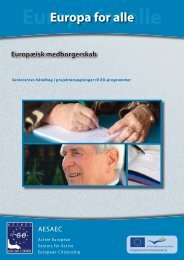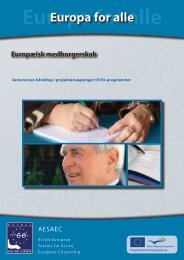We All are Europe - AESAEC
We All are Europe - AESAEC
We All are Europe - AESAEC
Create successful ePaper yourself
Turn your PDF publications into a flip-book with our unique Google optimized e-Paper software.
Module 2 – The Concept of Active <strong>Europe</strong>an Citizenship and its Relevance for Senior Citizens<br />
Listen / Read<br />
2.4.1. The Future Workshop (Shortened version)<br />
The Future Workshop (FW) method is not new. It was created in the 1970s by Robert Jungk, a German<br />
born Austrian writer and journalist, together with some colleagues. It has been used in many<br />
countries over the last decades as an appropriate tool for people willing to develop visions for addressing<br />
real-life problems. Originally it was developed as a method to support the political struggles<br />
of community groups for improved representation of their interests to create a better future<br />
worth living for.<br />
Basically, the Future Workshop can be divided into five phases:<br />
1. The preparatory phase, which involves deciding on the topic and making some practical arrangements<br />
(preparation of flip charts, papers, markers etc.)<br />
2. The critique phase, during which all the negative experiences related to the chosen topic <strong>are</strong><br />
brought into the open. In the critique phase the problem is critically and thoroughly discussed<br />
and investigated. Brainstorming is the preferred creative technique, followed by clustering<br />
and structuring the ideas, thoughts, comments etc. into some main sub-themes.<br />
3. The fantasy phase, in which the participants come up with ideas in response to the problems,<br />
by expressing their desires, fantasies and alternative views. In the fantasy phase the participants<br />
try to create a utopia, to draw an exaggerated picture of the future. Brainstorming and<br />
other creative techniques might be used. The participants should make a selection of the<br />
most interesting notions and develop these into a visionary paper.<br />
4. The implementation phase. The workshop concludes with the implementation phase, in which<br />
the ideas from the previous phase have been seen with more realistic eyes. The ideas <strong>are</strong><br />
checked and evaluated with regard to their practicability and a plan of action is drawn up.<br />
5. In the follow-up phase the FW ends with an agreement on the elaboration of a report that<br />
collects all the results gained and presents a completed action plan.<br />
2.4.2. The Visionary Workshop<br />
The Visionary Workshop (VW) consists of the Fantasy Phase and the Implementation Phase of the<br />
Future Workshop. The problem with the FW in relation to training courses is that it can take too<br />
long to go through all five phases. <strong>We</strong> therefore suggest focussing only on the FW’s most important<br />
phases which <strong>are</strong> the Fantasy Phase and the Implementation Phase of the workshop; together they<br />
<strong>are</strong> often called the Visionary Workshop.<br />
1. The Fantasy Phase<br />
Warming up: Before the participants start with their work it is advised to get them into a creative<br />
mood, e.g. they could listen to some music of their choice, they could play some games or<br />
they could use story telling as source of inspiration. Once everyone feels relaxed and comfortable<br />
the actual working part of the Fantasy Phase can begin.<br />
The work begins: In the Fantasy Phase the participants try to create positive pictures of the future<br />
in relation to the subject which the future workshop is addressing, by questioning themselves:<br />
How do we wish the future to be if it is not restricted by laws, economics, resources<br />
etc The participants should suggest solutions, whilst ignoring these restrictions, such as: How<br />
should life be for elderly people if the state has sufficient money to c<strong>are</strong> for all citizens who<br />
<strong>are</strong> not in the labour market How would it be to live in a society in which there is no discrimination<br />
of older people How would the EU be if older citizens had much greater power<br />
The participants have 10-15 minutes by themselves during which they should try to answer these<br />
questions and create suggestions about how the future could be. When they have finished the<br />
work, they should write their suggestions as headlines on a blackboard or flipchart. When all<br />
have written their headlines each participant should explain what their suggestion refers to.<br />
Very important: During this process there must not be any discussions!<br />
After the presentation of the headlines the next key question is: Which headlines cover the<br />
51




